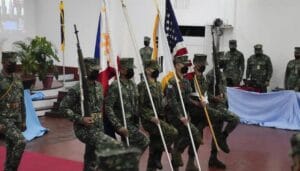US, Philippine forces hold combat drills to brace for crisis
More than 2,500 U.S. and Philippine marines joined combat exercises Monday to be able to respond to any sudden crisis in a region long on tenterhooks over South China Sea territorial disputes and increasing tensions over Taiwan.

MANILA, Philippines (AP) — More than 2,500 U.S. and Philippine marines joined combat exercises Monday to be able to respond to any sudden crisis in a region long on tenterhooks over South China Sea territorial disputes and increasing tensions over Taiwan.
The annual military drills are some of the largest so far between the longtime treaty allies under newly elected Philippine President Ferdinand Marcos Jr. His predecessor, Rodrigo Duterte, had been an outspoken critic of U.S. security policies and frowned on military exercises with American forces he said could offend China
Called Kamandag the Tagalog acronym for “Cooperation of the Warriors of the Sea” — the drills involve 1,900 U.S. Marines and more than 600 mostly Philippine counterparts in mock amphibious assaults and special operations, U.S. and Philippine military officials said. America’s HIMARS missile launchers and supersonic fighter jets will be in live-fire maneuvers that will end on Oct. 14, they said.
The venues include the western island province of Palawan, which faces the South China Sea, and the northern Philippines, across the Luzon Strait from Taiwan.
The military maneuvers in the Philippines are being held simultaneously with combat exercises between U.S. Marines and Japanese army self-defense forces on Japan’s northern island of Hokkaido that involve about 3,000 military personnel from both sides, U.S. military officials said.
RECOMMEND STORIES
- Royal Challengers Bengaluru Clinch Maiden IPL Title with Thrilling 6-Run Win Over Punjab Kings
- Remembering Ratan Tata: A Visionary Leader and Compassionate Humanitarian
- National College Colors Day – September 2, 2024: history
- Bison-ten Yell Day – September 2, 2024: history, FAQs
- National Lazy Mom’s Day – September 6, 2024
U.S. Maj. Gen. Jay Bargeron of the Japan-based 3rd Marine Division said the simultaneous exercises were aimed at bolstering the defensive capabilities of the U.S. alliances with the Philippines and Japan “through realistic combined training.”
“These exercises will allow our forces to strengthen interoperability and readiness to ensure we are prepared to rapidly respond to crisis throughout the Indo-Pacific,” Bargeron said in a statement.
“Our strength, resolve and commitment to our allies and partners in the region are our most effective deterrent,” U.S. Marine Lt. Col. Kurt Stahl told The Associated Press. “Together, we can deter potential adversaries from ever testing our capabilities or our relationships.”
In July, U.S. Secretary of State Antony Blinken called on China to comply with a 2016 arbitration ruling that invalidated Beijing’s vast territorial claims in the South China Sea and warned that Washington is obligated to defend the Philippines under the 1951 U.S.-Philippines Mutual Defense Treaty if Filipino forces, vessels or aircraft come under attack in the disputed waters.
The ruling was issued by an arbitration tribunal set up in The Hague under the U.N. Convention on the Law of the Sea after the Philippine government complained in 2013 about China’s seizure of a shoal off its northwestern coast. China did not participate, called the arbitration decision a sham and continues to defy it.
In addition to China and the Philippines, Vietnam, Malaysia, Taiwan and Brunei have had overlapping claims in the busy waterway, where an estimated $5 trillion in goods passes each year and which is believed to be rich in undersea gas and oil deposits.
Separately, President Joe Biden said last month that American forces would defend Taiwan if Beijing tries to invade the self-ruled island, sparking protests from China.
The long-simmering sea disputes and the increasingly tense relations between China and Taiwan have become key fronts of the U.S.-China rivalry.








